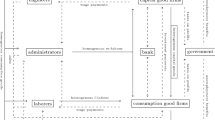Abstract
The paper describes an artificial world type model of an economy with heterogeneous firms and agents. The firms compete through process innovations and the reduction of costs obtained by good choices and allocations of types of workers. Firms learn to take good decisions through a neural network. In this environment recruitment policies affect growth and unemployment greatly A selection paradox emerges Ranking workers, by improving firms’ efficiency, makes growth less stochastic, and lowers unemployment as well as the proportion of long term unemployed 1.
Access this chapter
Tax calculation will be finalised at checkout
Purchases are for personal use only
Preview
Unable to display preview. Download preview PDF.
Similar content being viewed by others
References
Abernathy W.J. (1978). The Productivity dilemna: Roadblock to innovation in the automobile Industry. Baltimore and London: The John Hopkins University Press.
Agell J. and Lommerud K.E. (1995). Minimum wages and the incentives for skill formation. Working paper 1995:7, Uppsala.
Ballot G. and Taymaz E (1994). The dynamics of sums in a micro to macro model with training, learning and innovation. Forthcoming in the Journal of Evolutionary economics.
Becker G. S. (1962). Investment in Human Capital: a Theoretical Analysis. Journal of Political Economy, 70, 9 - 49.
Blanchard O.J. and Diamond P.(1990). Ranking, Unemployment Duration and Wages.Massachussetts Institute of Technology, mimeo.
Cahuc P. and Michel P. (1996). Minimum wage unemployment and growth. European economic Review, 40, 1463 - 1482.
Coleman J. (1988). Social Capital in the creation of Human Capital. American Journal of Sociology, 94, supplement, 95-120.
Dosi G. and alii (1988). Technical Change and Economic Theory. London: Pinter.
Eliasson G. (1979). Technical Change, Employment and Growth, Experiments on a Micro to Macro Model of Swedish Economy. NI research Report N°7, Stockholm.
Freeman R B. (1976). A cobweb model of the supply and starting salary of new engineers. Industrial and Labor Review, 29,236-46.
Harding A. (ed.) (1996). Microsimulation and public policy. Amsterdam: North Holland.
Holland J. (1975). Adaptation in natural and artificial systems. Ann Arbor: The University of Michigan Press.
Holland J. and Miller J.H. (1991). Artificial adaptative agents in economic theory. American Economic Review, Papers and Proceedings, 81 (2), 365 - 370.
Iwaï K. (1984a). Schumpeterian dynamics, part I: an evolutionary model of innovation and imitation. Journal of Economic Behavior and Organization, 5, 159 - 190.
Iwaï K. (1984b). Schumpeterian dynamics, part II: technological progress, firm growth and economic selection. Journal of Economic Behavior and Organization 5, 321 - 351.
Lane D.A. (1993). Artificial worlds and economics, part II. Journal of Evolutionary Economics 3 (3), 177 - 197.
Langrognet E and Merlateau M.P. (1995). Labor market and neural networks, Simulating Societies meeting, Miami, mimeo.
Machin S. (1996). Changes in the relative demand for skills. In A.L.Booth and D. Snower (eds.) Acquiring skills. Cambridge: Cambridge University Press.
Nelson R. and Winter S. (1982). An evolutionary theory of economic change. Cambridge: Harvard University Press.
Orcutt G.H et alii (1961). Microanalysis of socioeconomic systems: a simulation study. Harper Row.
Phelps E (1972). Inflation Policy and Unemployment Theory. New-York: Norton.
Pissarides C.A. (1992). Loss of skill during unemployment and the persistence of employment shocks. The Quaterly Journal of Economics, November.
Romer P. M., (1990). Endogenous Technological Change. Journal of Political Economy, 98, 71 - 102.
Schumpeter J.A. (1934). The theory of economic development. Cambridge: Harvard University Press.
Author information
Authors and Affiliations
Editor information
Editors and Affiliations
Rights and permissions
Copyright information
© 1997 Springer-Verlag Berlin Heidelberg
About this paper
Cite this paper
Ballot, G., Merlateau, MP., Meurs, D. (1997). Personnel Policies, Long Term Unemployment and Growth. An Evolutionary Model. In: Conte, R., Hegselmann, R., Terna, P. (eds) Simulating Social Phenomena. Lecture Notes in Economics and Mathematical Systems, vol 456. Springer, Berlin, Heidelberg. https://doi.org/10.1007/978-3-662-03366-1_21
Download citation
DOI: https://doi.org/10.1007/978-3-662-03366-1_21
Publisher Name: Springer, Berlin, Heidelberg
Print ISBN: 978-3-540-63329-7
Online ISBN: 978-3-662-03366-1
eBook Packages: Springer Book Archive




